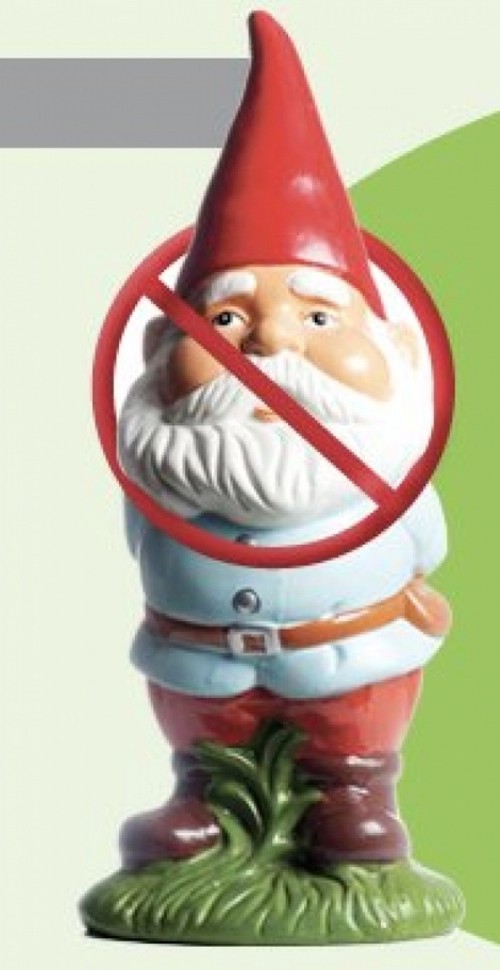Eat Your Yard Out
Salt Lake Art Center helps show that gnome is where the art is.
By Brian Staker @stakerizedThere can only be one. No, I’m not talking about the cheesy Scottish theatrical sword-wielder who spawned seemingly a dozen imitators and TV series. Rather, there can only be one champion lawn-sculpture artist. A new contest sponsored by the Salt Lake Art Center, “Lawn Gnomes Eat Your Heart Out,” spotlights an art form with which locals already have some expertise, and finds the apex of that unique genre combining topiary, sculpture and architecture into a public art form that people have made a part of their everyday lives.
Micol Hebron, the senior curator of exhibitions, describes the inspiration he had for the contest, shortly after she moved here in 2010. “One of the first things I noticed was the homes that had something artsy on their front lawns. I saw sculptures made from rocks, metal, recycled and natural things; one house had a large metal dinosaur.” Hebron found it an ideal way to invite residents to participate in an art project, in the tradition started by the 337 Project—which merged with the Art Center earlier this year.
A set of “ground rules” was created for the competition. Participating artworks will be judged by what Art Center Director Adam Price calls “the most brilliant jury ever assembled on the face of the planet,” and the winner will be awarded a $2,000 prize. Entrants are expected to provide upkeep through the one-month show, May 13-June 17, though Price imagines “it is possible that an artist may choose to create a work that is intended to change or dissolve over the course of the month.” Otherwise, participants are only limited by what is safe, legal and community-friendly.
This show challenges a lot of notions about artistic boundaries—and further, how we interact with our environment. “A front lawn is both public and private space,” Hebron notes. “It is the residents’ private property, yet it is visible to the whole neighborhood and contributes to the aesthetic of the community.” The front yard is highly emblematic. Especially in suburban America, it functions as, Hebron notes, “a kind of bumper sticker,” often proclaiming the ideologies or personal tastes of the people who live there. In a sense, the front lawn is the fondest expression of the American dream.
Viewers will be provided guide maps of sites around the city, and bicycle and pedestrian tours will also be given. “I hope this will be an opportunity for all of us to think a bit differently about the fabric of the city in which we live,” notes Price.
Framing these constructions as real works of art makes us look at these familiar sights in a new light. “Like [the mini-golf-themed show at SLAC in 2010], this project asks people to consider a space or a construct that is not typically considered ‘contemporary art’ as such,” says Hebron. “What changes our perceptions of something when we think of it as art?” The title of the show points at the “kitschy” tendencies of lawn decorations, and Hebron hopes people play with that as well as traditional ideas of public sculpture as a medium for commemorating significant figures. Hebron and Price envision a wide range of entries between those two extremes of artistic tone.
As an example of the personal touch that can be put into yard art, local metal sculptor Joe Casalino returned to his art after retiring. He was commissioned for a window display for Bloomingdale’s in New York in the 1960s, and put on one-man shows in NYC. After his studies at Hofstra University, he found that the job market for art teachers was tough, and by the late 1970s, he was a tool- and die-maker and machine-shop teacher at Salt Lake Community College. He is creating an entry composed of steel tubing welded together, saying, “I create mostly by feeling that each component belongs in a specific place within the sculpture. I use welding as the attachment means to solidify my vision.” His work will explore the cultural iconography of steel as well as demonstrate formal sculptural techniques.
The contest is an ingenious way of advancing the Art Center’s mission. “We seek to engage residents in a conversation about what contemporary art is, how it exists in our local and global environments, and how we each contribute to and participate in that dialogue,” Hebron explains.
“Lawn Gnomes” was consciously timed to coincide with the International Sculpture Center student award show at the Art Center, but the overlap won’t make things academic. “I’m personally hoping to have at least one real gnome on the jury,” quips Price, “but haven’t figured out how to make that happen yet.”
LAWN GNOMES
EAT YOUR HEARTS OUT
Salt Lake Art Center
20 S. West Temple
801-328-4201
May 13-June 17
Free
SLArtCenter.org
More by Brian Staker
-
Live Music Picks: April 12-18
Judas Priest, The Residents, Clownvis Presley, The Breeders and more.
- Apr 11, 2018
-
Loving the Alienation
Helios Creed and Chrome continue making iconoclastic music for outcasts.
- Mar 28, 2018
-
Live Music Picks: March 22-28
U.S. Girls, Ed Schrader’s Music Beat, Hell’s Belles, Columbia Jones and more.
- Mar 21, 2018
- More »



